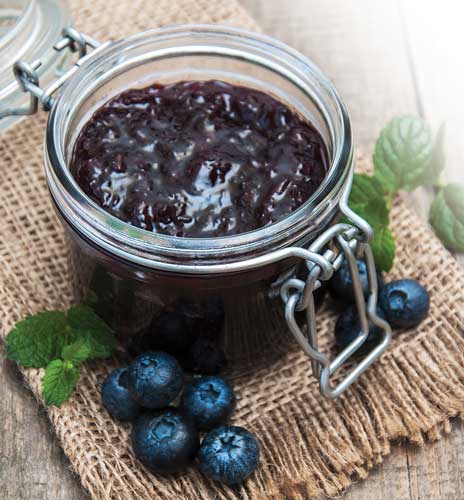Consumers avoiding GM foods; Fat + carbs light up the brain’s reward center
NEWS

Processed bilberry products are a valuable source of phenolics
A study published in the Journal of Food Science explores how various bilberry products (puree, infusion, liqueur, and fresh and pasteurized juices) differ in secondary metabolites as compared with the fresh fruit. For this purpose, the researchers identified phenolics with a liquid chromatography-mass spectrophotometry (LC-MS) system and compared phenolic profiles and phenolic contents in various bilberry products prepared from the same raw material.
The researchers found that processing significantly affected the biochemical pattern and levels of phenolics. Total analyzed phenolics decreased with processing, mostly due to anthocyanins, which had the highest share in phenolic profile of all bilberry-based products. Fresh fruits had the highest content of total anthocyanins (5,190 mg/100 g dry weight [DW]), followed by puree (2,719 mg/100 g DW), infusion (2,469 mg/100 g DW), and liqueur (1,830 mg/100 g DW), whereas fresh and pasteurized juices had the lowest content of total anthocyanins (921 and 1,099 mg/100 g DW, respectively).
Although consumers often believe that consuming fresh berries is more beneficial than processed products, the researchers concluded that “various bilberry-derived products can also be [a] valuable source of phenolic compounds all year round.”
Nearly half of U.S. consumers avoid GMO foods
Labels proposed by the U.S. Dept. of Agriculture’s Agricultural Marketing Service (USDA AMS) to disclose “bioengineered” (BE) foods dramatically increase a wide variety of consumer concerns, especially regarding human health.
The finding was the result of research conducted by the International Food Information Council (IFIC), which tested reactions to three BE labeling symbols and two variations of text disclosures. In every combination, levels of concern across a variety of factors increased—often substantially—when a disclosure label was applied.
For example, consumers were shown bottles of canola oil 1) without any BE logo or text; 2) with one of the three symbols (a plant, a sun, or a smile); 3) with a symbol, plus “bioengineered” in text; and 4) with a symbol, plus “may be bioengineered” in text. An additional group of consumers was shown just text disclosure, without any BE logo.
When shown the bottle without any disclosure, 31% of respondents had human health concerns. But the number rose to 50% when shown the BE plant symbol and increased to 51% when text was added to indicate “bioengineered.” Concern rose again, to 57%, when the wording “may be bioengineered” was added to the plant logo.
The survey also asked about broader perceptions of GMOs. More than one-third (36%) of respondents said they know very little or nothing about bioengineered or genetically modified foods, identical to the number who say they know a fair amount. Despite the low level of knowledge, a greater number (47%) said they avoid GMO foods at least somewhat.
“Despite broad scientific consensus that GMOs are safe to consume, a majority of Americans seem to be convinced otherwise. It’s a significant disconnect and it underscores the need for more creative public education on the science behind our food,” says Joseph Clayton, CEO of the IFIC Foundation.
Fat + carbs light up the brain’s reward center
The reward center of the brain values foods high in both fat and carbohydrates more than foods containing only fat or carbs, according to a study published in the journal Cell Metabolism.
In work that could help explain brain-body mechanisms underlying the genetic predisposition for obesity, eating in the absence of hunger, and difficulty losing or keeping off excess weight, senior author Dana Small, director of Yale University’s Modern Diet and Physiology Research Center, and her colleagues looked at the neural response to food cues.
Subjects underwent brain scans while viewing photographs of snacks containing mostly fat, mostly sugar, and a combination of fat and carbs. Allocated a limited amount of money to bid on foods, subjects were willing to pay more for foods that combined fat and carbohydrates. What’s more, the fat-carb combo lit up neural circuits in the reward center of the brain more than a favorite food, a potentially sweeter or more energy-dense food, or a larger portion size.
Our hunter-gatherer ancestors ate mostly woody plants and animal meat, note the researchers. “In nature, foods high in fat and carbohydrate are very rare and tend to have fiber, which slows metabolism,” Small says. “By contrast, it is very common for processed foods to have high fat and high carbohydrate loads.”
The researchers theorize that the simultaneous activation of fat and carbohydrate signaling pathways launches an effect that human physiology has not evolved to handle.
Mangoes may promote gut health
A study published in the journal Molecular Nutrition and Food Research suggests that the mango, which contains a combination of polyphenols and fiber, may be more effective than an equivalent amount of fiber powder in relieving constipation.
For the four-week study, participants with chronic constipation were randomly divided into two groups: the mango group ate about 300 grams of mango a day, while participants in the fiber group consumed the equivalent amount of fiber powder in their daily diet.
Throughout the study, the participants’ food intake was assessed by a questionnaire. The food intake analysis revealed that the mango and fiber groups consumed equivalent amounts of calories, carbohydrates, fiber, protein, and fat.
Measures of constipation severity were taken at the beginning and end of four weeks, and both groups improved over the course of the study. However, mangos were found to be more effective in reducing the symptoms of constipation in the participants than fiber alone. In addition, mango consumption helped to reduce certain biomarkers of inflammation.
 Health benefits spur yogurt market growth
Health benefits spur yogurt market growth
A new report published by Allied Market Research forecasts the global yogurt market to reach $107.2 billion by 2023 from $77.7 billion in 2016, growing at a CAGR of 4.6% from 2017 to 2023.
The main drivers of the market are yogurt’s health benefits and rising consumer concerns about obesity and the need to lose weight. Additional factors are growth in the retail market and the low lactose content of yogurt for lactose-intolerant individuals willing to eat dairy products. Among the factors that could restrict market growth are concerns about artificial additives and hormone-treated cows.
The yogurt drinks segment is projected to experience the highest CAGR, at 5.7% in revenue terms during the forecast period. The supermarket/hypermarket segment, which occupied the largest market in 2016, is expected to grow at the second highest CAGR, at 4.9%.
In 2016, Asia-Pacific and North America collectively accounted for more than 70% of market share and are anticipated to retain their position, due to significant growth of the food and beverage industries in China, India, and other developing economies, as well as the rising popularity of yogurt drinks in both regions.
News Bites
• ADM/Matsutani LLC announced that the U.S. Food and Drug Administration has included Fibersol on its list of approved dietary fibers.
• Bell Flavors & Fragrances recently launched new locations in Thailand and Indonesia.
• Arcadia Biosciences is partnering with The Farmer’s Business Network to expand the grower base for Arcadia’s GoodWheat varieties, scheduled to be commercially available in 2019.
• Beneo has opened a new Application Center in Parsippany, N.J., which will allow the company to work more closely with food and beverage manufacturers to develop nutritional and technical food applications.
• Cargill has invested in a new liquid chocolate production line in its Mouscron production facility in Belgium.
• The boards of directors of Conagra Brands and Pinnacle Foods unanimously approved a definitive agreement under which Conagra Brands will acquire all outstanding shares of Pinnacle Foods in a cash and stock transaction valued at approximately $10.9 billion, including Pinnacle Foods’ outstanding net debt.
• Ciranda has announced a new partnership with Matco Foods to produce and distribute organic brown rice syrup and organic clarified brown rice syrup in the U.S. food and beverage markets.
• Dean Foods has increased its ownership percentage and taken a majority stake in Good Karma Foods.
• Firmenich and Nelixia entered into a strategic partnership, which will significantly expand Nelixia’s high-quality and ethically sourced raw materials portfolio.
• Idaho Milk Products announced plans for a $26 million expansion to its Jerome, Idaho, facility.
• Ingredion introduced an interactive online portal, called Inside Idea Labs, which serves as an extension of the global network of Ingredion Idea Labs innovation centers. It is equipped with resources and content developed by the same experts who partner with customers at the company’s brick-and-mortar labs.
• Kroger and Home Chef, the country’s largest private meal kit company, finalized a merger that will significantly accelerate availability of meal kits.
• Mars named Andrew Clarke to the role of global president–Mars Wrigley Confectionery. Clarke will assume his new role in September.
• Molson Coors has acquired California-based beverage maker Clearly Kombucha.
• Roquette has signed an agreement to acquire Sethness Products, a leader in the production of caramel colors for food and beverage applications. The closing of the acquisition is expected to occur in the third quarter of 2018.
• Tyson Foods has expanded its portfolio of organic-branded chicken through the acquisition of Tecumseh Poultry, including the company’s air-chilled Smart Chicken brand.
• USHydrations celebrated the opening of a $20 million high-speed beverage manufacturing line in Pittston, Pa.
 Margaret Malochleb,
Margaret Malochleb,
Associate Editor
[email protected]
